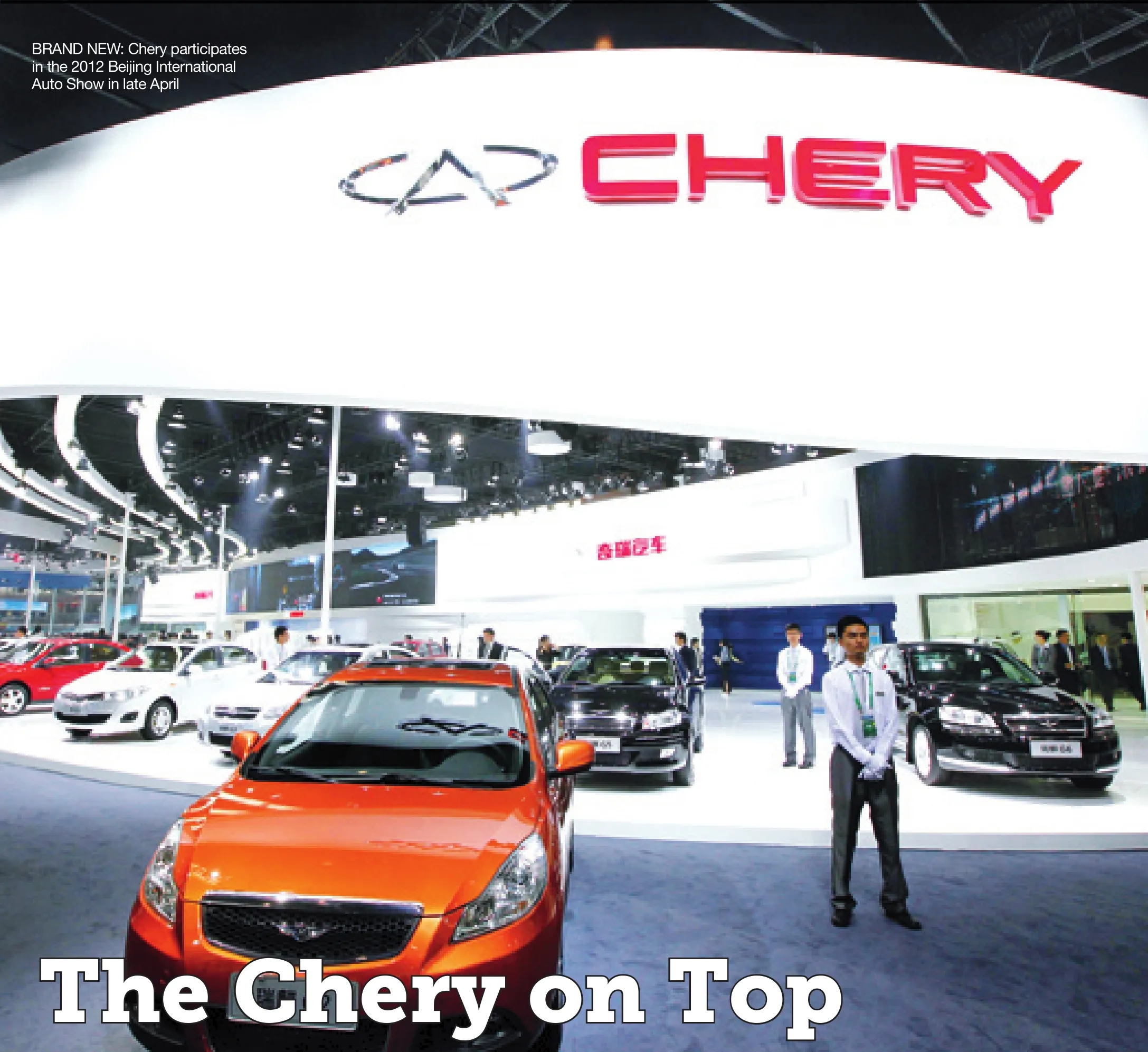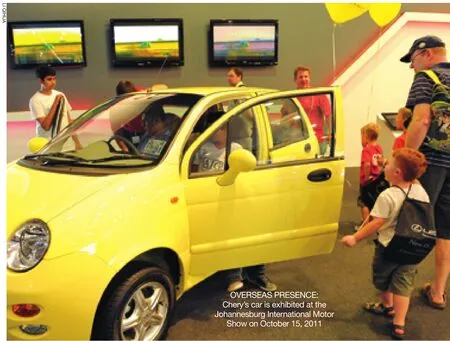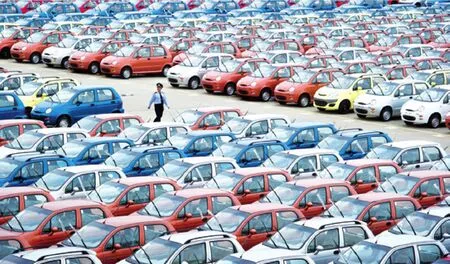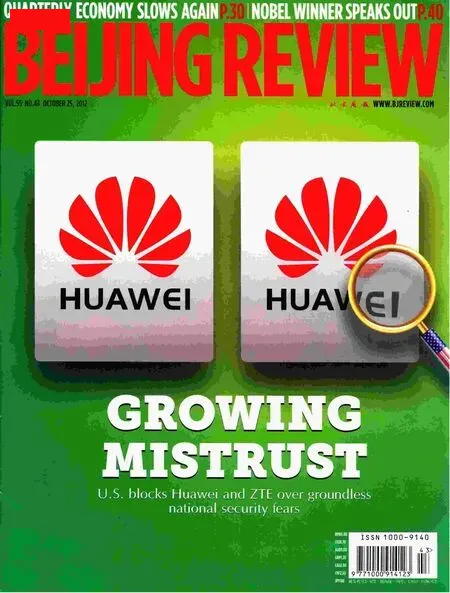The Chery on Top
By Hou Weili
The Chery on Top
By Hou Weili
Chinese carmaker struggles at home but makes deep inroads into emerging markets

BRAND NEW: Chery participates in the 2012 Beijing International Auto Show in late April
E legant body design, spacious modern interior and luxurious seats that massage the driver—all features you would associate w ith pricey high-end German sedans. But Chery Automobile, a leading homegrown Chinese auto manufacturer based in Wuhu, east China’s Anhui Province, is working hard to change perceptions and turn the luxury car market on its head. Chery’s Riich G6 model includes all the above features while retailing at 180,000-260,000 yuan($28,000-41,000).
However, the reality is that this luxury sedan, despite having a favorable price, was not well received by Chinese customers.
“Adm ittedly, the G6 is equipped w ith many advanced configurations which w ill not be available in cars in a similar price range produced by joint-venture automakers. But I prefer to buy a VW Passat or Nissan Teana,as these brands are more trustworthy,” said Ma Sheng. Ma runs a software company in Hefei, capital of Anhui Province, and was considering buying a sedan for the company.Negative customer feedback relating to the Riich G6 has embarrassed China’s native automakers, who offer an excellent pricequality ratio but lack brand recognition.Unfazed, Chery is forging ahead to find new ways of elevating its brand image and exploring overseas markets.
‘High-end’ d ream
Chery cannot ignore the changes in consumption trends if it is to survive and develop in the fiercely competitive auto world. Currently,urban consumers are upgrading to high-end cars when replacing current models. “W ith the advantage of favorable prices, Chinese self-owned automakers have grown by leaps and bounds during the past decades. But they have to launch higher-end products w ith more added value to meet the demands of current markets,” said auto analyst Zhang Zhiyong.
Having cherished the dream of grow ing to a high-end brand, Chery rolled out its selfowned high-end brands of Riich and Rely in succession, but didn’t bring significant elevation to Chery’s image. The road to becom ing a world-known brand for Chery seems to be rather bumpy.
Zhang said Chinese automakers m isunderstood the concept of high-end, as it is actually a dynamic process.
“A high-end brand will never be achieved only by manufacturing claimed high-end cars,like the Riich series,” said Zhang. He maintained that quality products had to be recognized by consumers so that the brand could acquire bargaining power among its competitors.
Chery didn’t slow down the pace toward its dream. In September, a 12-billion-yuan($1.9 billion) joint venture between Chery and Jaguar Land Rover, the world-renowned British brand, officially gained approval from China’s National Development and Reform Commission. The joint venture, to be located in Changshu, east China’s Jiangsu Province,w ill initially manufacture Land Rover SUVs,followed by Jaguars in the second phase. The two sides w ill share research and development, manufacturing, management and sales know ledge across the joint venture. The planned annual capacity is said to be 130,000 vehicles.
Zhang believed the huge demand for luxury sedans and SUVs in China’s burgeoning auto market is what sealed the deal. “The cooperation itself w ill bring considerable profit to the two sides,” Zhang said, noting that Chery will obtain cash flow and later loans from the tie-up to relieve its financial crunch, and learn from the transnational company’s experiences in management and product promotion.

“By cooperating w ith the world’s iconic brands, Chery w ill upgrade the quality of its products and the image of its own brand, a good move to push forward Chery’s goal of establishing a world-known brand,” Zhang said.
Go ing g loba l
Chery is acutely aware that development for the brand means seeking global options.According to Jin Yibo, Assistant to President of Chery Automobile, the share of overseas market has taken up to 35 percent of the enterprise’s total market. “Due to the restructuring of the Chinese economy and the cooling of the car market, exports declined dramatically in the past year. Despite this, Chery saw a steady grow th in exports,” Jin said.
In M ay and June this year, monthly exports of Chery exceeded 20,000 units, a record for Chinese auto exports. From January to July 2012, the company sold 112,014 vehicles in foreign markets, an increase of 26.1 percent year on year. About one third of Chinese autos exported during the first half year of 2012 were made by Chery, and it has been the biggest Chinese passenger vehicle exporter for nine consecutive years.
Chery’s overseas expansion began w ith exporting finished vehicles. Due to high tariffs, high transportation costs, long delivery periods and boycotts in foreign markets,Chery took initiatives to localize operations by establishing joint ventures or solely invested in overseas CKD (completely knocked down) factories and providing them w ith technologies, engines and sales and management skills. It has built up 16 CKD factories in countries like Egypt, Uruguay, Brazil and Russia and manufactured tailored vehicles for local consumers. Chery has exported its cars to more than 80 countries and regions all over the world and established a sales and service network of 1,153 branches.
“In the process of globalization, we gradually localize the products and the working staff to deepen the cooperation,” said Jin.
Taking Egypt as an example, Chery’s CKD factory in Cairo was the second largest Chinese project in the country after that of Huawei, recruiting about 2,000 local citizens.An estimated 40 percent of auto parts were provided by local suppliers. And the factory had an annual production capacity of about 20,000 to 30,000 vehicles, which ranked third among all vehicle brands sold in Egypt.
Zhang said Chinese automakers like Chery had several advantages when going abroad. They have made great strides in quality, technology and management since the late 1990s.
As the biggest export destination of Chinese automobiles is emerging markets,Zhang said the value of these achievements is more profi table in overseas markets.
“In the p ro cess o f g loba lization, w e g rad ua lly loca lize ou r p roduc ts and w o rk ing sta ff to deepen coop e ra tion.”
—Jin Yibo, Assistant to President of Chery Automobile

PRODUCTION BASE: Cars manufactured by Chery fresh off the p roduction line
This view was echoed by Jin. “Chery is more competitive and makes higher profits in foreign countries than in the domestic market,” he said, explaining that Chinese brands were well received overseas thanks to its growing economy. “Chery’s image is also elevated. Our vehicles can be priced at the same level as those from South Korean automakers, which generally sell at higher prices in Chinese domestic markets,” Jin added.
Another advantage is that Chinese automakers don’t necessarily do many market surveys when going abroad because customers’ demands and income levels in the emerging markets are sim ilar to those in China, said Zhang. Moreover, the competition between Chinese auto producers and multinationals is less fierce in overseas markets. China’s automakers initially targeted the m iddle and low-end markets, while their foreign competitors focused on the urban high-end market. “Before 2005, they operated separately and had little competition, which is now reflected in the overseas emerging markets, making the huge potential there an opportunity for Chinese automakers,” said Zhang.
Lo ca liza tion
Like other Chinese enterprises going abroad,Chery encountered problems when integrating into foreign markets. “The biggest problem was cultural differences,” said Jin. He said the Chinese habit of working late and long hours is not followed in Latin America and A frica.“We respect locals’ mindsets and follow their working style. Facing such conditions,Chinese technicians w ill take the lead and do some work supposed to be done by local employers,” Jin added. Chery gained popularity and support overseas among local people and authorities as it brought skills, jobs, worked w ith local suppliers and was socially responsible, he said.
In Jin’s eyes, when enterprises go abroad,they bridge the people-to-people exchanges between the two countries. “By doing business in Latin America or Africa, we learned the local culture and customs. And the locals also w itnessed Chinese virtues of hard work and diligence, as well as our company’s philosophy of creativity and dedication,” said Jin.

